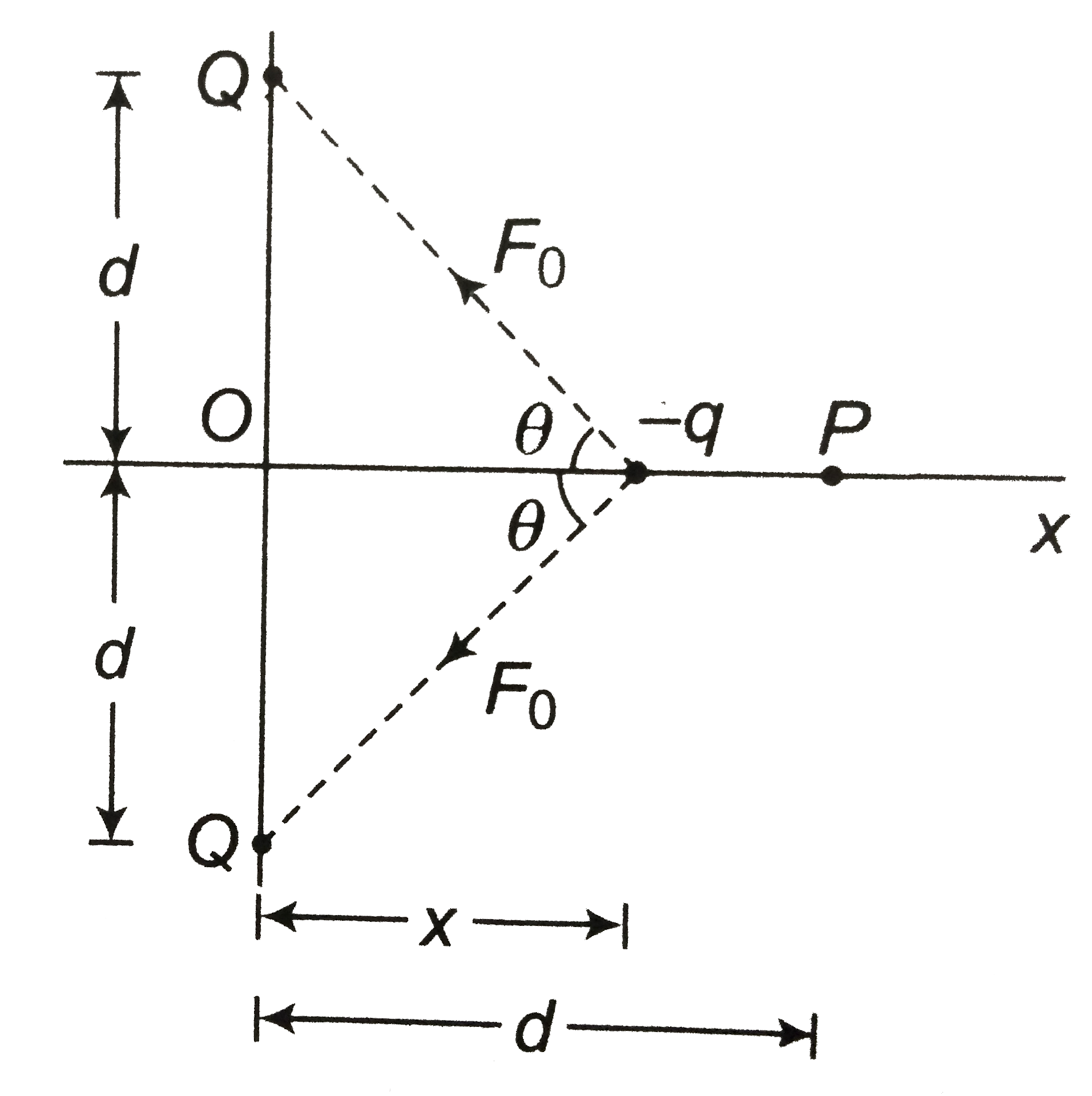Two equal positive charges , Q , are fixed at points (0,d) and (0,−d) on the y-axis. A charged particle having charge −q and mass m is released from rest at point (d,0) on the x-axis . Discuss the motion of charged particle.
The charge −q will be attracted by charges Q. Let at some instant charged particle is at distance x from origin O.
The resultant force on −q,
F=2F0cosθ=2.14π∈0Qq(d2+x2).x(d2+x2)1/2
=Qqx2π∈0(d2+x2)3/2
Here , the restoring force F is not directly proportional to displacement x , hence the particle will not execute S.H.M.
The motion of particle is oscillatory of amplitude d.
If initial position of charged particle is close to O such that x<<d.
Restoring Force F=−Qqx2π∈0d3
Acceleration a=Fm=−Qqx2π∈0md3=−ω2x
T=2πω=2π√2π∈0md3Qq

Topper's Solved these Questions
Similar Questions
Two point charges Q are kept fixed on XY-plane at points A(0, d) and B(0, -d). Another point charge -q with mass m is held at a point, on the positive side of X-axis that is at the distance 2d from both the fixed point charges. What will be the magnitude of acceleration of the negative point charge (i) just after it is released from its location? (ii) at an instant it crosses the origin?
View SolutionTwo points charges , each Q , are fixed at separation 2d. A charged particle having charge q and mass m is placed between them.
(a) Now this charged particle is slightly displaced along the line joining the charges , slow that it will execute simple harmonic motion and find the time period of oscillation.
(b) If charge q is negative and it is displaced slightly perpendicular to the line joining the charges , repeat the part (a).
View Solution
Knowledge Check
Two equal positive charges Q are fixed at points (a, 0) and (−a,0) on the x-axis. An opposite charge -q at rest is relased from point (0, a) on the y-axis. The charge -q will
AMove to infinityBMove to origin and rest thereCUndergo SHM about the originDExecute oscillatory motion but not SHMTwo equal negative charges −q are fixed at points (0,−a) and (0,a) on y-axis. A poistive charge Q is released from rest at point (2a,0) on the x-axis. The charge Q will
A(a) execute simple harmonic motion about the originB(b) move to the origin remain at restC(c) move to infinityD(d) execute oscillatory but not simple harmonic motionWhen charge is given to a soap bubble, it shows:Two equal negative charges -q are fixed fixed at point (0, -a) and (0,a) on y-axis. A positive charge Q is released from rest at the point (2a, 0) on the x-axis. The charge Q will:
Aan increase in sizeBsometimes an increase and sometimes a decrease in sizeCno change in sizeDnone of these
Consider two positive point charges, each of magnitude q, placed on the y-axis at the points (0, a) and (0, -a). A positively charged particle of charge q' and mass m is displaced slightly from the origin in the direction of the positive x-axis.
At the origin, charge q' will be in
View SolutionConsider two positive point charges, each of magnitude q, placed on the y-axis at the points (0, a) and (0, -a). A positively charged particle of charge q' and mass m is displaced slightly from the origin in the direction of the positive x-axis.
Speed of charge q' at infinity is
View SolutionConsider two positive point charges, each of magnitude q, placed on the y-axis at the points (0, a) and (0, -a). A positively charged particle of charge q' and mass m is displaced slightly from the origin in the direction of the positive x-axis.
At the origin, charge q' will be in
View SolutionTwo equal negative charges are fixed at points and on y-axis. A positive charge Q is released from rest at the point on the x-axis. The charge Q will:
View SolutionA charged particle of mass m and charge q is released from rest in an electric field of constant magnitude E. The kinetic energy of the particle after time t is
View Solution
